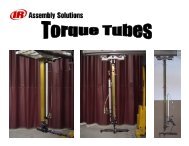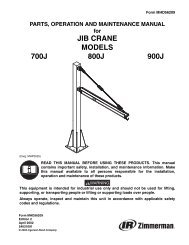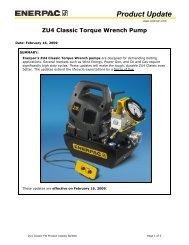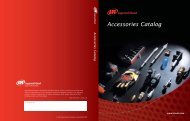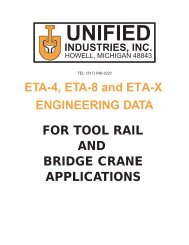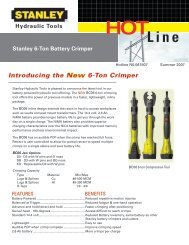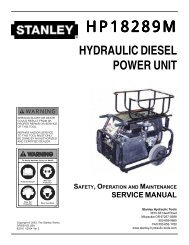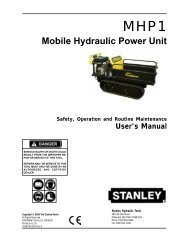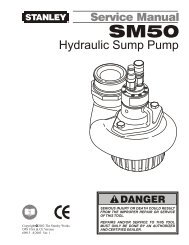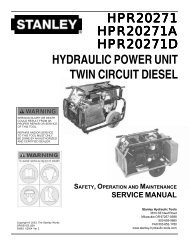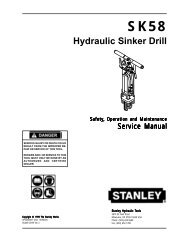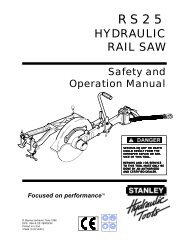CraneBrdgKit CatNos904535 904536 904538 - 113535 ... - Tool-Smith
CraneBrdgKit CatNos904535 904536 904538 - 113535 ... - Tool-Smith
CraneBrdgKit CatNos904535 904536 904538 - 113535 ... - Tool-Smith
You also want an ePaper? Increase the reach of your titles
YUMPU automatically turns print PDFs into web optimized ePapers that Google loves.
Page 16<br />
INSTRUCTIONS FOR ASSEMBLING<br />
MOTOR DRIVEN SINGLE DRIVE<br />
CRANE BRIDGE<br />
1. Follow instructions for assembling push crane bridge.<br />
2. Locate and drill holes for cross shaft supports.<br />
3. Bolt the cross shaft support angles to the bridge beam. The flat<br />
washer goes under the bolt head and the beveled washer goes<br />
between the beam flange and the lockwasher and nut.<br />
4. Bolt the motor to the gear reducer with four hex head bolts and<br />
lockwashers and bolt the support plate to the gear reducer with<br />
two hex socket head cap screws and lockwashers. The drive may<br />
go on either end of the bridge. Optional motor-gear reducer<br />
locations are shown in Figure 8. The vent (Ref. No. 15 in Figure<br />
16) must be placed in the highest location.<br />
5. Place key in truck drive shaft, slide gear reducer into place over<br />
shaft and bolt support plate to side of truck with two hex socket<br />
head cap screws and lockwashers. Maximum allowable torque is<br />
10 pound feet. Tighten six set screws in gear reducer hollow shaft<br />
(Ref. No. 18 in Figure 16).<br />
6. Using the 9/32" diameter hole in the support plate as a guide,<br />
drill a 5/16" diameter hole through the support plate and truck<br />
side and drive the groove pin, furnished, into the hole (Ref. No.<br />
4 in Figure 16).<br />
7. Attach a flange bearing to each cross shaft support plate with<br />
two carriage bolts, lockwashers and hex nuts. The carriage bolt<br />
head locks in the bearing (see Figure 13).<br />
8. Place the proper number of bearings and couplings on the<br />
cross shaft, set the unit in place and clamp the cross shaft support<br />
plates to the cross shaft support angles.<br />
9. Check horizontal alignment of the cross shaft by using a taut<br />
line. Weld plates to angles when alignment is complete. Weld as<br />
shown in Section A-A of Figure 7.<br />
10. Check the space between cross shafts; it should be 1/8".<br />
Position the couplings and drill 1/4" diameter holes through the<br />
shaft and coupling using the holes in one side of the coupling as<br />
a guide. Shaft and coupling is secured by socket head cap<br />
screws with flat washers and self-locking hex nuts (see Figure<br />
14). Tighten set screws in flange bearings.<br />
11. The electrical enclosure is shown mounted on the inside of<br />
the truck over the gear reducer in Figure 17. The connecting<br />
bracket may be mounted in any of 3 vertical locations on the<br />
enclosure bracket when oriented as shown. It may also be<br />
rotated 180° (out standing leg at top) giving 3 additional positions.<br />
The enclosure bracket may also be adjusted horizontally on the<br />
enclosure. The connecting bracket may be welded to a truck or<br />
to the girder. If the bracket rests on the supporting member, a 1"<br />
minimum overlap is required. Weld as shown in Figure 9. If the<br />
bracket is to be supported by weld at the toe only, a stiffener plate<br />
must be furnished by the crane fabricator. Weld as shown in the<br />
alternate view in Figure 9.<br />
12. Mount fused disconnect switch in any safe, convenient<br />
location.<br />
INSTRUCTIONS FOR ASSEMBLING<br />
MOTOR DRIVEN DUAL DRIVE<br />
CRANE BRIDGE<br />
1. Follow instructions for assembling push crane bridge.<br />
2. Bolt the motors to the gear reducers with four hex head bolts<br />
and lockwashers orienting the motor junction boxes appropriately<br />
after selecting the motor-gear reducer location from the options<br />
illustrated in Figure 8. Bolt the support plate to the gear reducer<br />
with two hex socket head cap screws and lockwashers. The<br />
highest oil plug in the gear reducer must be removed and the vent<br />
be installed. The hardware, vent and support plate are provided<br />
with the gear reducer.<br />
3. Place the key in the truck drive shaft and slide the gear reducer<br />
hollow shaft onto the drive shaft over the key. Bolt the support<br />
plate to the side of the truck with two hex socket head cap screws<br />
and lockwashers. Maximum allowable bolt torque is 10 pound<br />
feet.<br />
4. Repeat instruction 3 at the opposite end truck.<br />
5. The electrical enclosure is shown mounted on the inside of the<br />
truck over the gear reducer in Figure 17. The connecting bracket<br />
may be mounted in any of 3 vertical locations on the enclosure<br />
bracket when oriented as shown. It may also be rotated 180°<br />
(outstanding leg at top) giving 3 additional positions. The enclosure<br />
bracket may also be adjusted horizontally on the enclosure. The<br />
connecting bracket may be welded to a truck or to the girder. If the<br />
bracket rests on the supporting member, a 1" minimum overlap<br />
is required. Weld as shown in Figure 9. If the bracket is to be<br />
supported by weld at the toe only, a stiffener plate must be<br />
furnished by the crane bridge fabricator. Weld as shown in the<br />
alternate view in Figure 9.<br />
6. Mount fused disconnect switch in any safe convenient location.<br />
PAINTING<br />
After assembly, all plain steel surfaces should be painted.<br />
Thoroughly clean surfaces of oily spots and rust using a suitable<br />
solvent. It is recommended that a national brand zinc-chromate<br />
primer be applied before a finish coat of high gloss enamel<br />
especially suited for steel surfaces.<br />
MARKING<br />
Codes require that the capacity of the bridge be shown on both<br />
sides of crane bridge, legible from the floor. Normal practice for<br />
marking is to use capacity in tons, for example: 1 TON, 2 TON,<br />
etc. Stencil forms are readily available that may be used with<br />
brush-on or pressurized spray-can paint.<br />
NOTICE<br />
The crane builder and user are responsible for marking crane and<br />
also to check for compliance with all local, state and national<br />
codes.



